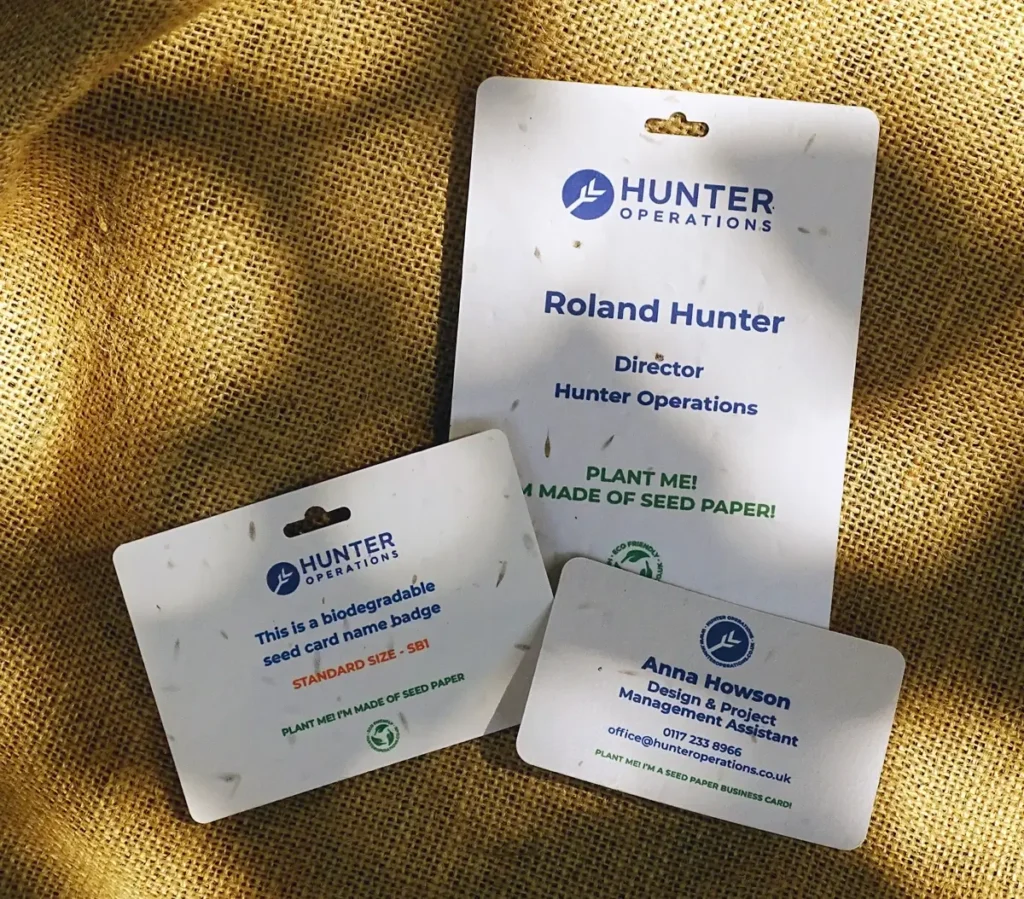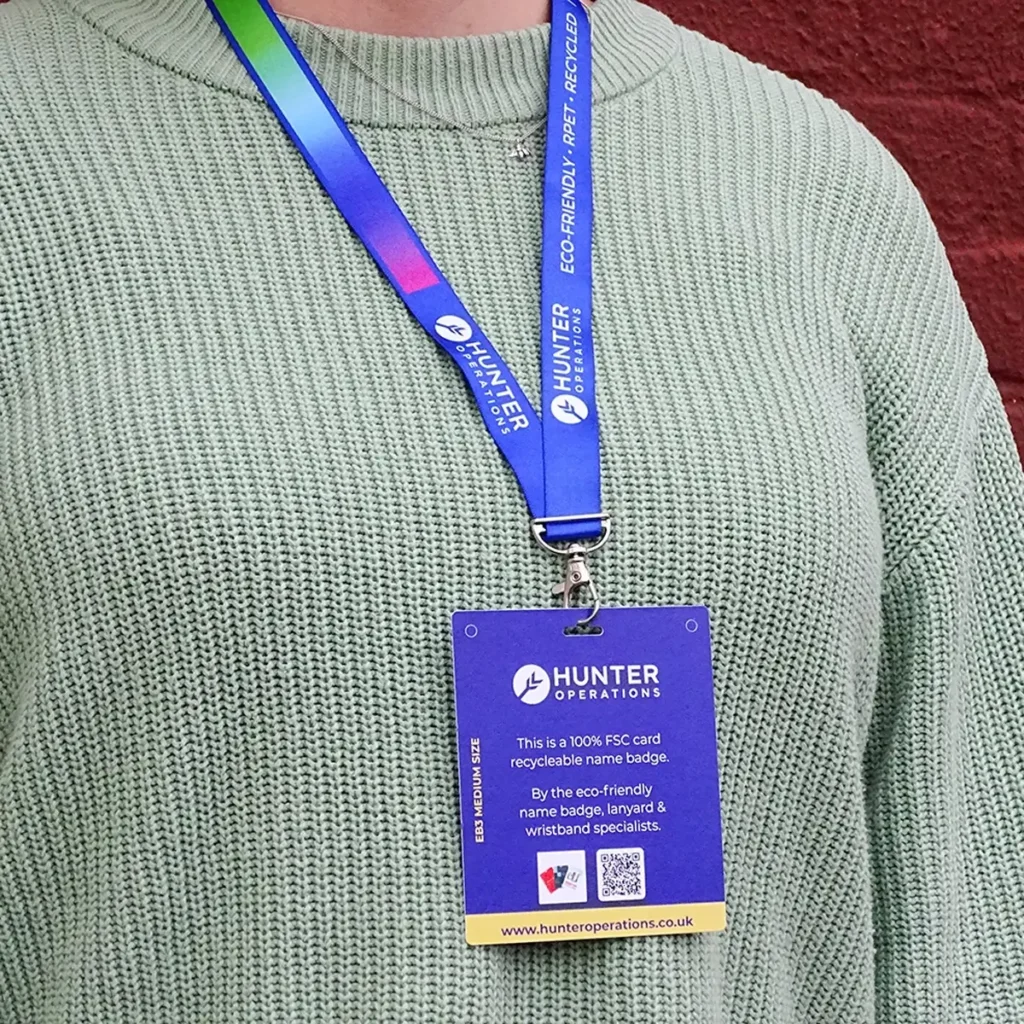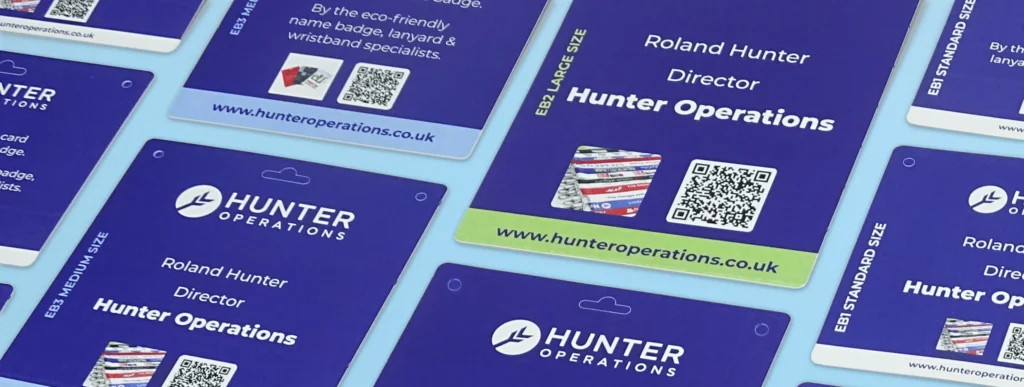Every event tells a story — but so does every product you use within it.
At Hunter Operations, we believe in total transparency about the journey our products take. In this blog, we’re taking you behind the scenes of one of our most popular sustainable products: the recycled PET (RPET) lanyard.
From discarded plastic bottles to durable, branded badge holders — here’s how we transform waste into something meaningful, responsible, and proudly wearable.
Why Tell the Story of a Lanyard?
Lanyards are a staple of events, conferences, exhibitions, trade shows, and corporate gatherings. But in the face of global plastic waste and the demand for sustainable alternatives, the humble lanyard is now under scrutiny.
Telling the life cycle story:
- Educates attendees about your sustainability efforts
- Builds transparency and trust in your brand
- Demonstrates innovation and environmental stewardship
With growing focus on green procurement and ISO 14001 or ISO 20121 standards, knowing where your products come from — and what happens to them after use — is not a bonus. It’s essential.
Stage 1: Post-Consumer Plastic Collection
The RPET lanyard journey begins in recycling centres. This stage focuses on collection and sorting of plastic waste, primarily PET (Polyethylene Terephthalate), which is commonly used in:
- Soft drink and water bottles
- Food containers
- Packaging materials
These items are collected via curbside recycling, commercial recycling schemes, or bottle return programmes.
Sorting and Cleaning:
After collection, materials are:
- Sorted by type (PET vs other plastics)
- Washed thoroughly to remove labels, glue, and residues
- Inspected for quality control to ensure only usable PET is retained
Transparency Tip: Not all recycled plastic is the same. At Hunter Operations, we use certified post-consumer PET to ensure consistent sustainability claims.
Stage 2: Shredding and Reprocessing
Once cleaned, the PET plastic is sent to reprocessing facilities. Here, it goes through the transformation from rigid bottle to flexible yarn:
Step-by-Step Process:
- Shredding – Bottles are chopped into flakes.
- Melting – The flakes are melted at high temperatures.
- Extrusion – The melted plastic is extruded into fine filaments.
- Spinning – Filaments are cooled and spun into RPET yarn.
- Weaving – Yarn is woven into lanyard tape material.
The result is a soft, durable ribbon that feels almost identical to virgin polyester — but comes with a fraction of the environmental cost.
Environmental Savings:
Compared to virgin polyester:
- RPET uses up to 59% less energy
- Produces lower CO₂ emissions
- Diverts waste from landfill or incineration
Sustainability Fact: It takes approx. 1 recycled plastic bottle to make one standard RPET lanyard.
Stage 3: Custom Branding & Finishing
Now that the RPET fabric exists, it’s time to turn it into something branded and beautiful.
Dyeing & Printing:
- Fabric is dyed to match your brand colours (using low-impact, water-based dyes)
- Printing methods:
- Silkscreen (single colour logos)
- Sublimation (full colour, photographic quality)
- Woven-in logos (long-lasting, premium finish)
Custom Options:
- Width (10mm, 15mm, 20mm, 25mm)
- Single or double-sided printing
- Optional taglines (e.g., “Made from Recycled Bottles”)
Attachment Options:
- Metal clips (swivel, lobster, carabiner)
- Safety breakaways (important for public/school events)
- Badge reels or retractable clips
At Hunter Operations, all print and customisation is handled in certified facilities with ethical production standards.
Stage 4: Assembly & Packaging
After branding, lanyards are assembled with clips, toggles, or fasteners. At this stage, we also match them with corresponding badge holders — often made from recyclable materials or biodegradable alternatives.
We offer pre-assembly for clients who want to save hours of event preparation time. Your lanyards arrive:
- Badges inserted
- Bundled by delegate type or session
- Alphabetised or grouped by role (e.g., Speaker, Guest, Staff)
Packaging Considerations:
We ship in minimal packaging:
- No plastic sleeves unless requested
- Bundled using paper ties or recycled twine
- Bulk packed by default to reduce unnecessary waste
Transparency Tip: Ask your supplier about their packaging policy. Sustainability shouldn’t stop at the product — it should include delivery too.
Stage 5: The Event Experience
When delegates arrive at your event and receive their RPET lanyards, it’s an opportunity to communicate your brand values.
How to Tell the Story:
- Add a printed note to the badge: “This lanyard is made from recycled plastic bottles.”
- Display signage near registration or collection points
- Include a QR code on the badge or event guide linking to the lanyard life cycle story
- Use social media to show your commitment to responsible sourcing
This isn’t just about ticking a sustainability box. It’s about connecting with attendees in a meaningful way.
Stage 6: After the Event – Reuse or Recycle
What happens to the lanyard afterwards?
Many attendees keep lanyards as mementos. But for those that don’t, having a reuse or return plan adds credibility to your environmental message.
Post-Event Options:
- Collection Bins: Set up clearly labelled collection stations for used lanyards and badge holders
- Donation Schemes: Some schools, charities, or community groups reuse clean lanyards
- Return & Reuse: We offer a service for clients who want to recollect and reuse branded lanyards
- Recycling: RPET can be reprocessed again — keeping the loop going
Tip: Include a message encouraging attendees to return or reuse. Something as simple as:
“Let’s give this lanyard another life — drop yours in the bin by the door.”
Building Trust Through Transparency
At Hunter Operations, we don’t just sell lanyards — we help tell their story. We believe in:
- Clear communication of material sourcing and certification
- Eco-conscious production with minimal waste and ethical labour
- Smart logistics that support carbon efficiency
- Post-event support for circular reuse and recycling
Transparency builds credibility. And credibility builds trust.
Why RPET Lanyards Are the Future of Event Branding
Eco lanyards are not a gimmick — they’re a smart, practical response to global expectations. Here’s why:
- They look and feel just as good as traditional lanyards
- They cost similar — or sometimes less — than virgin polyester
- They contribute to a circular economy
- They give your attendees something to talk about
Every RPET lanyard you distribute is a tiny act of sustainability — and a statement of intent.
Final Thoughts: From Waste to Worth
The life cycle of an RPET lanyard is more than just a manufacturing process. It’s a transformation — of waste into value, of plastic into purpose, and of a simple accessory into a sustainable storytelling tool.
By choosing recycled lanyards from Hunter Operations, you’re making a practical choice that aligns with a bigger vision — a cleaner, more conscious event industry.
You’re not just giving your delegates something to wear. You’re giving them something to believe in.
Ready to order recycled lanyards that reflect your values? Contact Hunter Operations today to request a quote, sample pack, or artwork template. Let’s turn waste into something wonderful — together.





